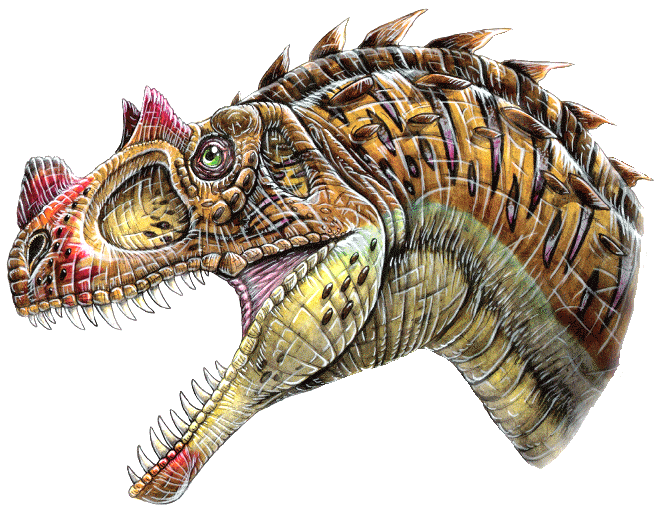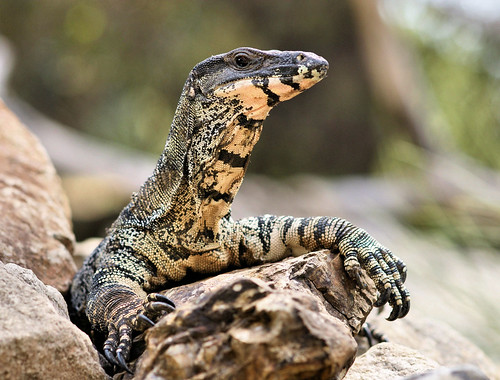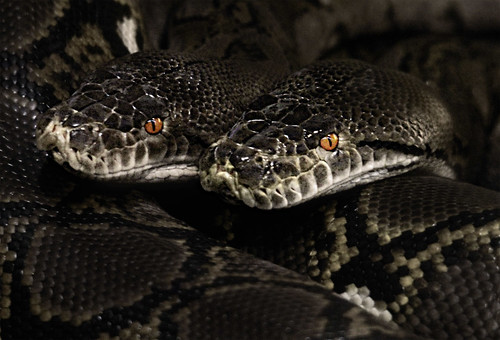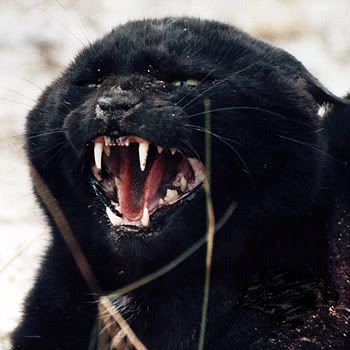|
|
Post by Deinobrontornis on Nov 23, 2011 22:05:16 GMT -5
Grizzly Bear - Ursus arctos horribilis The grizzly bear (Ursus arctos horribilis), also known as the silvertip bear, the grizzly, or the North American brown bear, is a subspecies of brown bear (Ursus arctos) that generally lives in the uplands of western North America. Most adult female grizzlies weigh 130–200 kilograms (290–440 lb), while adult males weigh on average 180–360 kilograms (400–790 lb). The average total length in this subspecies is 198 centimeters (6.50 ft), with an average shoulder height of 102 centimeters (3.35 ft) and hindfoot length of 28 centimeters (11 in). Newborn bears may weigh less than 500 grams (1 lb). In the Yukon River area, mature female grizzlies can weigh as little as 100 kilograms (220 lb). On the other hand, an occasional huge male grizzly has been recorded which greatly exceeds ordinary size, with weights reported up to 680 kilograms (1,500 lb). Although variable from blond to nearly black, grizzly bear fur is typically brown in color with white tips. A pronounced hump appears on their shoulders; the hump is a good way to distinguish a black bear from a grizzly bear, as black bears do not have this hump. Muskox - Ovibos moschatus The muskox (Ovibos moschatus, musk ox) is an Arctic mammal of the family Bovidae, noted for its thick coat and for the strong odor emitted by males, from which its name derives. This musky odor is used to attract females during mating season. Muskoxen primarily live in Arctic North America and Greenland, with small introduced populations in Sweden, Siberia and Norway. As members of the subfamily Caprinae of the family Bovidae, muskoxen are more closely related to sheep and goats than to oxen, but are in their own genus, Ovibos (Latin: "sheep-ox"). Both sexes have long curved horns. Muskoxen stand 1.2 m (4 ft) high at the shoulder on average, with females measuring 135 to 200 cm (4.4 to 6.6 ft) in length, and males 200 to 250 cm (6.6 to 8.2 ft). Adults, on average, weigh 285 kg (600 lb) and range from 180 to 400 kg (400 to 900 lb). Their life expectancy is 12–20 years. The thick coat and large head often suggests a larger animal than the muskox truly is, but heavy zoo-kept specimens have weighed up to 650 kilograms (1,400 lb). Their coat, a mix of black, gray, and brown, includes long guard hairs that almost reach the ground. Rare "white muskoxen" have been spotted in the Queen Maud Gulf Bird Sanctuary.
|
|
|
|
Post by Super Communist on Nov 23, 2011 22:14:01 GMT -5
Don't see the grizzly being able to inflict any serious damage while I don't doubt that the musk ox's horns can deliver serious blunt trauma.
Gotta go with the herbivore here.
|
|
|
|
Post by Deinobrontornis on Nov 24, 2011 0:08:25 GMT -5
Don't see the grizzly being able to inflict any serious damage while I don't doubt that the musk ox's horns can deliver serious blunt trauma. Gotta go with the herbivore here. The muskox (Ovibos moschatus) is a large ungulate (the average male weight is from 273 to 364 kg [600 to 800 pounds]) equipped with curved horns and a shaggy pelage which can be up to 10 cm (4 inches) thick. It is a close relative of the sheep or goats (subfamily Caprinae) and is able to withstand incredibly frigid, arctic conditions (down to at least – 70 ºF). Muskox tend to live in herds and are famous for their defensive posturing – they often form a defensive circle with their heads (i.e., armament) facing outward toward the potential threat. Youngsters often hide amongst the adults for protection. The barren-ground grizzly bears and muskox overlap in their distribution in northern Canada and Alaska. This shaggy beast would appear to be fairly impervious to grizzly attack. But, this is not the case. Grizzlies were originally reported feeding on muskox by early explorers and with recent reintroduction of these ungulates in parts of the Arctic, there have been a number of papers written on the predator-prey relationship of U. arctos and O. moschatus. Below I have reviewed what is known about the barren-ground grizzly predation on muskox. Multiple Hunting Strategy: In the Thelon Game Sanctuary, grizzlies and muskox coexist, but the relationship is not always copasetic. Near the Thelon River, bears may use thick willow stands along the waterway to ambush muskox feeding on sedge in nearby clearings. Willows also attract muskox, as it is a preferred food of this beast. Gunn and Miller (1982) report finding a bear on a freshly killed, bull O. moschatus. They were able to scare the adult bear off and examine its kill and concluded that the bear had dispatched the big ungulate by first grasping its nose (crushing the nasal turbine bones and tearing off the nose in the process) and then inflicting a crippling bite to its skull. By grasping the nose, the bear may have prevented the muskox from bringing its horns to bear and also may have been more effective at throwing the animal to the ground. In another study carried out in the northeastern Arctic slopes of Alaska, 92 grizzly-muskox interactions were observed (Reynolds et al. 2002). Fifty percent of these were known kills, 40 % were possible kills or scavenging events, and 10 % were incidents where a grizzly was seen chasing muskox. It was estimated that 16-39 % of muskox mortality was the result of bear predation. During the study period (1982-2001) the number of muskox killed by grizzly bears was zero to two deaths per year before 1993, one to four musk ox per year from 1994-1997 and five to ten deaths per year from 1998-2001. This increase in kill numbers was a function of an increase in the size of musk ox herds. An increase in kills may also be indicative of the bears learning how to better attack and take down these big, formidable animals. While solitary adult bears were most often seen attacking muskox (69 occasions), pairs or trios of adult bears were seen chasing, killing or eating these animals (three episodes). Sows with cubs or yearlings were seen interacting with muskox on three occasions. Surplus Killing: Grizzly bears sometimes engage in surplus killing of muskox. In the study carried out by Reynolds et al. (2002) there were ten episodes where one to three bears killed from two to four adult muskox. On several occasions even more muskox were dispatched during a single hunting bout. For example, in one case five individuals (two adult females, a yearling and unsexed adult musk ox) were incapacitated by a single bear. In another case, a grizzly killed four calves and in another incident the victims were one adult female, one two-year old male and one yearling. In most cases, solitary bears were involved in these killing sprees, but in one case three grizzlies instigated the melee. Clarkson et al. (1993) reported a fascinating case of surplus killing of muskox calves by a heterosexual pair of adult grizzlies. Within a distance of about two km, the two bears took down five young musk ox. By doing a little forensic work, the researchers were able to put together a likely picture of what had happened. Rather than form a defensive circle to try and parry the bear attacks, this herd of musk ox tried to out run the grizzlies. The researchers postulated that the calves trailed behind the adults and, therefore, were more vulnerable. The two bears chased the herd, which consisted of 40 to 50 muskox (with a minimum of eight calves). They killed the first calf and ate 90 % of the carcass. They then chased the herd down again and about 1.5-2.0 km from the first kill dispatched a second young musk ox. They ate 60 % of this second calve and began the hunt again. They killed the third calf about 300 m from the second. The third calf was about 30 % consumed by the bears and a wolverine (Gulo gulo) that was feeding on the carcass when the researchers arrived on the scene. The fourth calve was killed 400 m from the third. A golden eagle had just begun to feed on calf four when the researchers arrived. The final calf was killed about 200 m from the fourth – this last young muskox was not eaten either. Source: gobiestogrizzlies.blogspot.com/2008/07/muskox-on-menu-grizzly-predation-on.html |
|
|
|
Post by avianaves on Dec 5, 2011 10:02:19 GMT -5
Great account. Grizzlies are capable of killing musk oxens but the ungulate would be the winner head on because of its larger size.
|
|
|
|
Post by Deinobrontornis on Dec 6, 2011 16:15:08 GMT -5
Great account. Grizzlies are capable of killing musk oxens but the ungulate would be the winner head on because of its larger size. Both are identical in size. Grizzly bears with experience typically win even in head-to-head conflicts. |
|
|
|
Post by Canid Cetus Aves on Dec 6, 2011 16:39:00 GMT -5
I think the Grizzly Bear wins because there are reports of them attacking Musk Ox.
|
|
|
|
Post by jumbo on May 18, 2012 0:22:02 GMT -5
cool info but it didn't state that bears killed healthy adult male musk ox in prime condition. Here we are assuming 2 prime male specimens, face to face, no ambush scenario. In most cases DB mentioned, the oxen either ran away or were young individuals. A prime bull ox standing his ground ready to slug it out is an entirely different game. www.youtube.com/watch?v=pNfljgxTLyI Bears have long claws but they are dulled by the daily grind. They'd have trouble penetrating the ox's thick fur and fat layers. www.mnzoo.org/animals/animals_muskox.asp "Bulls give off a strong scent during rutting season, and are so aggressive they will even chase off birds that perch too near to cows." www.adfg.alaska.gov/index.cfm?adfg=muskox.main "During the rut, bulls battle in spectacular and violent contests. After a period of aggressive displays, the bulls charge at top speed from distances of 50 yards or more and collide squarely on the horn bosses. After a clash, the bulls back away from each other swinging their heads from side to side and repeat the sequence until one bull turns and runs away. Battles have included upwards of 20 clashes. Bull muskoxen have heavily armored skulls to protect them from the shock of impact. Four inches of horn and three inches of bone lie directly over the brain in the area of contact." A dominant bull musk ox is a very tough opponent for a grizzly no doubt. Don't forget bears lack the agility and experience of big cats in handling this kind of opponent. Bears attack by grabbing onto the head and wrestling which plays entirely into the ox's favor. All I see happening is the ox busting the bear's ribs and throwing him like a roll of toilet paper. If anything this is a mismatch in favor of the ox. Ox 8/10 EDIT: "inflicting a crippling bite to its skull." How is a bear with its weak, narrow jaws supposed to do that? |
|
|
|
Post by rhino on Mar 11, 2013 15:47:00 GMT -5
Don't see the grizzly being able to inflict any serious damage while I don't doubt that the musk ox's horns can deliver serious blunt trauma. Gotta go with the herbivore here. I agree. Bears are weak, pathetic predators and have no way to do serious damage on the muskox. The bear's thin jaws and worn down claws can't penetrate ox's fur and fat. Plus the bear's method of attack- grabbing the head and horns then wrestling is basically asking the ox to gore and thrash his exposed chest and neck. Bears can't even kill each other with paw swipes so there's no way a paw swipe is going to kill the larger ox. |
|
Venomous Dragon
Archeon
 The Varanid
The Ora, King of The Lizards.
The Varanid
The Ora, King of The Lizards.
Posts: 2,037
|
Post by Venomous Dragon on Mar 11, 2013 17:43:03 GMT -5
Don't see the grizzly being able to inflict any serious damage while I don't doubt that the musk ox's horns can deliver serious blunt trauma. Gotta go with the herbivore here. I agree. Bears are weak, pathetic predators and have no way to do serious damage on the muskox. The bear's thin jaws and worn down claws can't penetrate ox's fur and fat. Plus the bear's method of attack- grabbing the head and horns then wrestling is basically asking the ox to gore and thrash his exposed chest and neck. Bears can't even kill each other with paw swipes so there's no way a paw swipe is going to kill the larger ox. to be fair not much of anything can kill a large animal with a paw swipe (flukes aside) bears are not weak and clearly dont have thin jaws  |
|
|
|
Post by rhino on Mar 11, 2013 20:33:56 GMT -5
Your picture isn't showing up for some reason. Bears have weaker jaws than big cats is what I meant. A big cat has shorter, broader jaws + longer canines = stronger bite than a bear. Besides that, I cannot see a bear, an animal with little experience killing large prey taking on a even a reasonably healthy muskox. To be honest the only animals IMO that can kill or cripple a similar sized animal with a single strike of its appendage are ankylosaurs, doedicurus (those giant armadillos with spike clubs at the end of their tails), and stegosaurs. And of course humans  . |
|
Venomous Dragon
Archeon
 The Varanid
The Ora, King of The Lizards.
The Varanid
The Ora, King of The Lizards.
Posts: 2,037
|
Post by Venomous Dragon on Mar 11, 2013 21:33:00 GMT -5
^its just a bear skullat equal size tigers and lions do have stronger bites but imo once you reach a certin point bite force becomes less important, kinda like a 45 cal vs a 50 cal if it hits you in the head your dead either way so the size of the bullet isnt that important (not factoring differences in range as thats less important when it comes to jaws)
|
|
Reticulatus
Ichthyoid
   http://fantasyfaceoff.proboards.com
http://fantasyfaceoff.proboards.com
Posts: 709
|
Post by Reticulatus on Mar 11, 2013 22:28:30 GMT -5
Your picture isn't showing up for some reason. Bears have weaker jaws than big cats is what I meant. A big cat has shorter, broader jaws + longer canines = stronger bite than a bear. Besides that, I cannot see a bear, an animal with little experience killing large prey taking on a even a reasonably healthy muskox. To be honest the only animals IMO that can kill or cripple a similar sized animal with a single strike of its appendage are ankylosaurs, doedicurus (those giant armadillos with spike clubs at the end of their tails), and stegosaurs. And of course humans  . Don't exclude the mantis shrimp. |
|
Deleted
Deleted Member
Posts: 0
|
Post by Deleted on Apr 26, 2013 15:47:20 GMT -5
The bear would almost always win a long tiresome fight. The mosk ox is well protected by fur but it also causes them to be less maneuverable. Its small horns are not effective in goring. Finally musk ox arent that big, people seem to think they are bison-sized but its all fur. Grizzly 8/10.
|
|
|
|
Post by rhino on Apr 27, 2013 18:47:34 GMT -5
that thick fur and fat layers is more than decent protection from the bear's blunt claws and teeth.
|
|
|
|
Post by Felis Rex on Apr 27, 2013 20:24:52 GMT -5
Many old bear baiting accounts, the classic bear vs bull comes to mind.
|
|


















 .
.


